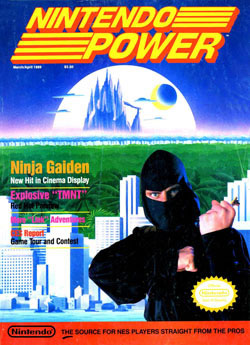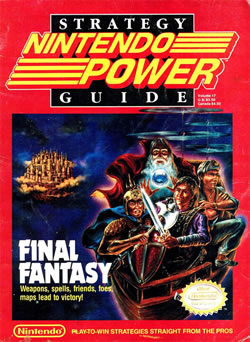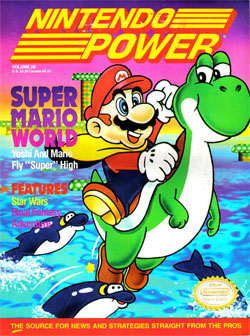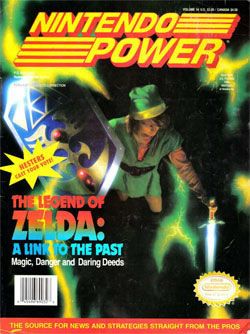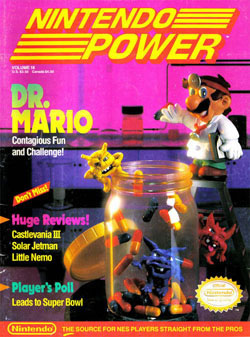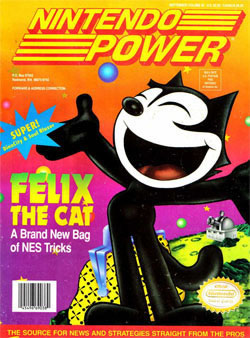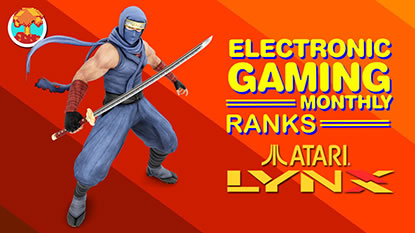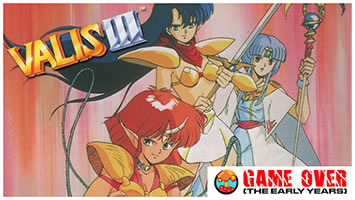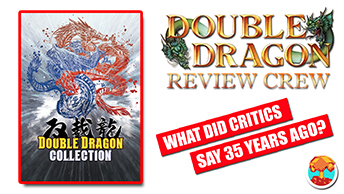- CLASSIC MAGAZINES
- REVIEW CREW
A show recapping what critics thought back
when classic games first came out! - NEXT GENERATION'S BEST & WORST
From the worst 1-star reviews to the best
5-stars can offer, this is Next Generation! - NINTENDO POWER (ARCHIVE)
Experience a variety of shows looking at the
often baffling history of Nintendo Power! - MAGAZINE RETROSPECTIVE
We're looking at the absolutely true history of
some of the most iconic game magazines ever! - SUPER PLAY'S TOP 600
The longest and most ambitious Super NES
countdown on the internet! - THEY SAID WHAT?
Debunking predictions and gossip found
in classic video game magazines! - NEXT GENERATION UNCOVERED
Cyril is back in this spin-off series, featuring the
cover critic review the art of Next Generation! - HARDCORE GAMER MAGAZING (PDF ISSUES)
Download all 36 issues of Hardcore Gamer
Magazine and relive the fun in PDF form!
- REVIEW CREW
- ELECTRONIC GAMING MONTHLY
- ELECTRONIC GAMING MONTHLY RANKS
From Mario to Sonic to Street Fighter, EGM
ranks classic game franchises and consoles! - ELECTRONIC GAMING MONTHLY BEST & WORST
Counting down EGM’s best and worst reviews
going year by year, from 1989 – 2009! - ELECTRONIC GAMING BEST & WORST AWARDS
11-part video series chronicling the ups and
downs of EGM’s Best & Worst Awards!
- ELECTRONIC GAMING MONTHLY RANKS
- GAME HISTORY
- GAME OVER: STORY BREAKDOWNS
Long-running series breaking down game
stories and analyzing their endings! - A BRIEF HISTORY OF GAMING w/ [NAME HERE]
Real history presented in a fun and pithy
format from a variety of game historians! - THE BLACK SHEEP
A series looking back at the black sheep
entries in popular game franchises! - INSTANT EXPERT
Everything you could possibly want to know
about a wide variety of gaming topics! - FREEZE FRAME
When something familiar happens in the games
industry, we're there to take a picture! - I'VE GOT YOUR NUMBER
Learn real video game history through a series
of number-themed episodes, starting at zero! - GREAT MOMENTS IN BAD ACTING
A joyous celebration of some of gaming's
absolute worst voice acting!
- GAME OVER: STORY BREAKDOWNS
- POPULAR SHOWS
- DG NEWS w/ LORNE RISELEY
Newsman Lorne Riseley hosts a regular
series looking at the hottest gaming news! - REVIEW REWIND
Cyril replays a game he reviewed 10+ years
ago to see if he got it right or wrong! - ON-RUNNING FEUDS
Defunct Games' longest-running show, with
editorials, observations and other fun oddities! - DEFUNCT GAMES QUIZ (ARCHIVE)
From online quizzes to game shows, we're
putting your video game knowledge to the test!- QUIZ: ONLINE PASS
Take a weekly quiz to see how well you know
the news and current gaming events! - QUIZ: KNOW THE GAME
One-on-one quiz show where contestants
find out if they actually know classic games! - QUIZ: THE LEADERBOARD
Can you guess the game based on the classic
review? Find out with The Leaderboard!
- QUIZ: ONLINE PASS
- DEFUNCT GAMES VS.
Cyril and the Defunct Games staff isn't afraid
to choose their favorite games and more! - CYRIL READS WORLDS OF POWER
Defunct Games recreates classic game
novelizations through the audio book format!
- DG NEWS w/ LORNE RISELEY
- COMEDY
- GAME EXPECTANCY
How long will your favorite hero live? We crunch
the numbers in this series about dying! - VIDEO GAME ADVICE
Famous game characters answer real personal
advice questions with a humorous slant! - FAKE GAMES: GUERILLA SCRAPBOOK
A long-running series about fake games and
the people who love them (covers included)! - WORST GAME EVER
A contest that attempts to create the worst
video game ever made, complete with covers! - LEVEL 1 STORIES
Literature based on the first stages of some
of your favorite classic video games! - THE COVER CRITIC
One of Defunct Games' earliest shows, Cover
Critic digs up some of the worst box art ever! - COMMERCIAL BREAK
Take a trip through some of the best and
worst video game advertisements of all time! - COMIC BOOK MODS
You've never seen comics like this before.
A curious mix of rewritten video game comics!
- GAME EXPECTANCY
- SERIES ARCHIVE
- NINTENDO SWITCH ONLINE ARCHIVE
A regularly-updated list of every Nintendo
Switch Online release, plus links to review! - PLAYSTATION PLUS CLASSIC ARCHIVE
A comprehensive list of every PlayStation
Plus classic release, including links! - RETRO-BIT PUBLISHING ARCHIVE
A regularly-updated list of every Retro-Bit
game released! - REVIEW MARATHONS w/ ADAM WALLACE
Join critic Adam Wallace as he takes us on a
classic review marathon with different themes!- DEFUNCT GAMES GOLF CLUB
Adam Wallace takes to the links to slice his way
through 72 classic golf game reviews! - 007 IN PIXELS
Adam Wallace takes on the world's greatest spy
as he reviews 15 weeks of James Bond games! - A SALUTE TO VAMPIRES
Adam Wallace is sinking his teeth into a series
covering Castlevania, BloodRayne and more! - CAPCOM'S CURSE
Adam Wallace is celebrating 13 days of Halloween
with a line-up of Capcom's scariest games! - THE FALL OF SUPERMAN
Adam Wallace is a man of steel for playing
some of the absolute worst Superman games! - THE 31 GAMES OF HALLOWEEN
Adam Wallace spends every day of October afraid
as he reviews some of the scariest games ever! - 12 WEEKS OF STAR TREK
Adam Wallace boldly goes where no critic has
gone before in this Star Trek marathon!
- DEFUNCT GAMES GOLF CLUB
- DAYS OF CHRISTMAS (ARCHIVE)
Annual holiday series with themed-episodes
that date all the way back to 2001!- 2015: 30 Ridiculous Retro Rumors
- 2014: 29 Magazines of Christmas
- 2013: 29 Questionable Power-Ups of Christmas
- 2012: 34 Theme Songs of Christmas
- 2011: 32 Game Endings of Christmas
- 2010: 31 Bonus Levels of Christmas
- 2009: 30 Genres of Christmas
- 2008: 29 Controls of Christmas
- 2007: 34 Cliches of Christmas
- 2006: 33 Consoles of Christmas
- 2005: 32 Articles of Christmas
- 2004: 31 Websites of Christmas
- 2003: 29 Issues of Christmas
- 2002: 28 Years of Christmas
- 2001: 33 Days of Christmas
- NINTENDO SWITCH ONLINE ARCHIVE
- REVIEW ARCHIVE
- FULL ARCHIVE
Five Things You Didn't Know About Nintendo Power
For many of us, Nintendo Power was the gateway drug to harder video game magazines. With its eye-catching cover designs and an emphasis on detailed strategy guides, Nintendo Power toed the line between informative news source and wildly biased propaganda machine. No matter where you come down on this long-running magazine, it's interesting to look back at some of the misconceptions people have about Nintendo Power's early days.
Let's take a look at the numbers. Between March of 1989 and December 1995, Nintendo Power reviewed a total of 1,503 games across four different platforms. The average score was 3.3 out of 5. Compare this to GamePro, which averaged a 4.1 out of 5 in the same period of time. Nintendo Power's 3.3 is in line with Electronic Gaming Monthly, and yet you rarely hear people complain about a Sushi-X bias.
And it's not like Nintendo Power's scores improved as the years went along. In fact, the exact opposite is true. Between 1989 and 1990, Nintendo Power averaged a score of 3.4. Over the next three years, the magazine plateaued at 3.3. And then starting in 1994, the average decreased a tick to 3.2.
The system averages are just as predictable. Between 1989 and 1995, Nintendo Power reviewed 488 games for the original 8-bit Nintendo Entertainment System. The average score was 3.3. Nintendo Power reviewed 645 Super NES games, with a score of, you guessed it, 3.3. And then there's the Game Boy, which saw 358 reviews with an average score of 3.2.
So the next time somebody tells you that Nintendo Power was a cheerleader that praised everything, I expect you to rattle off at least seven minutes of boring number and averages in order to prove your point. Then call him a douche. Because nobody likes to be called a douche.
As expected, Super Mario World quickly won critics over, with Nintendo Power going as far to give the game a staggering 4.5. Up to that point, only a dozen games had scored a 4.5. Super Mario World was in an elite group that included The Adventures of Bayou Billy, Ninja Gaiden, Battletoads and Super Mario Bros. 3. But here's the strange thing, this 2D platformer was not the highest scoring Super NES launch title.
In a weird twist of fate, Nintendo Power gave SimCity a 4.6 out of 5, making it the magazine's top scoring launch game. The editors loved it, stressing how "loaded with new great features" it was. It had no trouble besting F-Zero (which scored a 4 out of 5), Pilotwings (3.8 out of 5) and Gradius III (3.6 out of 5). It may not have been the system's best looking game, but SimCity was Nintendo Power's top pick at the Super NES launch.
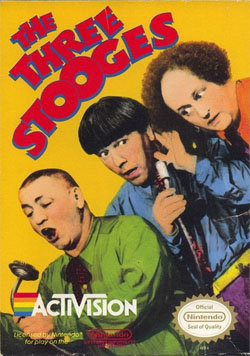
One of Nintendo Power's favorite games!
SimCity and Super Mario World made it look easy, but getting a score of 4.5 or higher was incredibly hard. How hard? Before 1996, only nineteen games managed such a high score from Nintendo Power. Of this group, eleven games were on the Nintendo Entertainment System, seven were on the Super NES and only one was for the Game Boy (Kirby's Pinball Land). With more than 1,500 reviews, only 1.3% of the games scored at least a 4.5.
This surprisingly low number is all the more shocking when you look at which games made the cut. Many of the games make sense, such as Ninja Gaiden, Battletoads, Shadowrun, Super Metroid, Final Fantasy II, Chrono Trigger, Batman: The Video Game and Super Mario Bros. 3. Many of these are undisputed classics, so nobody would fault Nintendo Power's high scores. But can the same be said about The Three Stooges, The Addam's Family and Stealth Eagle?
Believe it or not, The Three Stooges was Nintendo Power's top scoring game for a number of months. With an impressive 4.7 out of 5, this licensed action game was only surpassed by Castlevania III: Dracula's Curse (4.8 out of 5) and Zelda III: A Link to the Past (4.9 out of 5). Not even Super Metroid, Super Mario World or SimCity could beat The Three Stooges.
Speaking of which, it's interesting to see which games came just shy of the 4.5 score. Huge Nintendo releases like Super Mario Kart, Donkey Kong Country, Wario Land and Metroid II: Return of Samus just missed the cut. The same was true for major third-party releases like Super Star Wars, Super Castlevania IV, NBA Jam, Street Fighter II and Maniac Mansion.
I'm not sure why the sudden change, but Nintendo Power started reviewing Game Boy releases in their November/December 1990 issue. More than a year late, the magazine reviewed 15 black & white carts, including Amazing Penguin, Battle Ball, Bubble Ghost, Dr. Mario, DuckTales, Ghostbusters II, Ninja Boy, RoboCop and Soccer Mania. It was an unimpressive lot, with only Dr. Mario scoring a 4.
For what it's worth, the magazine did not make the same mistake with the Virtual Boy. Nintendo Power decided to review all four 1995 launch titles, averaging a middling 3.3. Space shooter Red Alarm came out on top with a score of 3.5 out of 5. The rest of the list boils down to Mario's Tennis (3.4), Galactic Pinball (3.3) and Teleroboxing (3.2). Not exactly the most encouraging line-up of games
The sad truth is that Nintendo Power had already forgotten about the 8-bitter. Forget Wario's Woods in 1995, the last time Nintendo Power featured an NES game on the cover was October 1992, featuring Felix the Cat and his brand new bag of tricks. With most developers turning their attention to the Super NES, the old school systems were only featuring on a smattering of covers in the early 1990s.
Still, we can't be too sad about the fate of the Nintendo Entertainment System. This is a system that managed to stay relevant for the better part of a decade, and Nintendo Power was there most of the way. It's fun to think back to a simpler time, when games didn't have DLC and nobody complained on Twitter. But while you sit there reminiscing about the good old days, remember that Nintendo Power gave The Three Stooges a higher score than Super Metroid. Seriously, what the hell?
FOR MORE NINTENDO POWER: Don't forget to check out our weekly episodes of Nintendo Power Uncovered, where our resident Cover Critic rates two decade's worth of magazine covers. And don't forget to follow us on Twitter.
Nintendo Power Reviews Were Not Wildly Biased
Every critic has to fight charges of bias, but that's especially tricky when you're working for the world's largest video game maker. If you've always suspected that Nintendo Power was little more than a cheerleader for their games, then you're not alone. With a name like Nintendo Power, it's normal to expect every game to get a perfect score. But I'm here to tell you that this myth is busted.Let's take a look at the numbers. Between March of 1989 and December 1995, Nintendo Power reviewed a total of 1,503 games across four different platforms. The average score was 3.3 out of 5. Compare this to GamePro, which averaged a 4.1 out of 5 in the same period of time. Nintendo Power's 3.3 is in line with Electronic Gaming Monthly, and yet you rarely hear people complain about a Sushi-X bias.
And it's not like Nintendo Power's scores improved as the years went along. In fact, the exact opposite is true. Between 1989 and 1990, Nintendo Power averaged a score of 3.4. Over the next three years, the magazine plateaued at 3.3. And then starting in 1994, the average decreased a tick to 3.2.
The system averages are just as predictable. Between 1989 and 1995, Nintendo Power reviewed 488 games for the original 8-bit Nintendo Entertainment System. The average score was 3.3. Nintendo Power reviewed 645 Super NES games, with a score of, you guessed it, 3.3. And then there's the Game Boy, which saw 358 reviews with an average score of 3.2.
So the next time somebody tells you that Nintendo Power was a cheerleader that praised everything, I expect you to rattle off at least seven minutes of boring number and averages in order to prove your point. Then call him a douche. Because nobody likes to be called a douche.
SimCity > Super Mario World
By summer 1991, Nintendo Power couldn't contain their excitement for the brand new Super Nintendo Entertainment System. This 16-bit console came packaged with Super Mario World, one of the most anticipated
sequels of all time. With all eyes on the Italian plumber, the entire world waited to hear if Mario's first 16-bit adventure was worth the sixteen month wait. As expected, Super Mario World quickly won critics over, with Nintendo Power going as far to give the game a staggering 4.5. Up to that point, only a dozen games had scored a 4.5. Super Mario World was in an elite group that included The Adventures of Bayou Billy, Ninja Gaiden, Battletoads and Super Mario Bros. 3. But here's the strange thing, this 2D platformer was not the highest scoring Super NES launch title.
In a weird twist of fate, Nintendo Power gave SimCity a 4.6 out of 5, making it the magazine's top scoring launch game. The editors loved it, stressing how "loaded with new great features" it was. It had no trouble besting F-Zero (which scored a 4 out of 5), Pilotwings (3.8 out of 5) and Gradius III (3.6 out of 5). It may not have been the system's best looking game, but SimCity was Nintendo Power's top pick at the Super NES launch.
The Highest Scoring Games Will Surprise You

One of Nintendo Power's favorite games!
This surprisingly low number is all the more shocking when you look at which games made the cut. Many of the games make sense, such as Ninja Gaiden, Battletoads, Shadowrun, Super Metroid, Final Fantasy II, Chrono Trigger, Batman: The Video Game and Super Mario Bros. 3. Many of these are undisputed classics, so nobody would fault Nintendo Power's high scores. But can the same be said about The Three Stooges, The Addam's Family and Stealth Eagle?
Believe it or not, The Three Stooges was Nintendo Power's top scoring game for a number of months. With an impressive 4.7 out of 5, this licensed action game was only surpassed by Castlevania III: Dracula's Curse (4.8 out of 5) and Zelda III: A Link to the Past (4.9 out of 5). Not even Super Metroid, Super Mario World or SimCity could beat The Three Stooges.
Speaking of which, it's interesting to see which games came just shy of the 4.5 score. Huge Nintendo releases like Super Mario Kart, Donkey Kong Country, Wario Land and Metroid II: Return of Samus just missed the cut. The same was true for major third-party releases like Super Star Wars, Super Castlevania IV, NBA Jam, Street Fighter II and Maniac Mansion.
Radio Silence at the Game Boy Launch
While Nintendo Power was quick to review the five Super NES launch games, the same cannot be said about the Game Boy in
1989. For the first year, the magazine decided to hold off on giving proper scores and simply previewed each game. That means that titles like Alleyway, Super Mario Land and Tetris were never given number grades like games on other systems.I'm not sure why the sudden change, but Nintendo Power started reviewing Game Boy releases in their November/December 1990 issue. More than a year late, the magazine reviewed 15 black & white carts, including Amazing Penguin, Battle Ball, Bubble Ghost, Dr. Mario, DuckTales, Ghostbusters II, Ninja Boy, RoboCop and Soccer Mania. It was an unimpressive lot, with only Dr. Mario scoring a 4.
For what it's worth, the magazine did not make the same mistake with the Virtual Boy. Nintendo Power decided to review all four 1995 launch titles, averaging a middling 3.3. Space shooter Red Alarm came out on top with a score of 3.5 out of 5. The rest of the list boils down to Mario's Tennis (3.4), Galactic Pinball (3.3) and Teleroboxing (3.2). Not exactly the most encouraging line-up of games
The Final Days of the Nintendo Entertainment System
Just how enduring was the Nintendo Entertainment System? It took Nintendo six years and 58 issues before going a month without a single NES review. Nine issues later, Nintendo
Power ran their final review for the 8-bit stalwart, Wario's Woods (they gave it a 3.1 out of 5). For a system with so many amazing games, Nintendo's first console went out with a whimper.The sad truth is that Nintendo Power had already forgotten about the 8-bitter. Forget Wario's Woods in 1995, the last time Nintendo Power featured an NES game on the cover was October 1992, featuring Felix the Cat and his brand new bag of tricks. With most developers turning their attention to the Super NES, the old school systems were only featuring on a smattering of covers in the early 1990s.
Still, we can't be too sad about the fate of the Nintendo Entertainment System. This is a system that managed to stay relevant for the better part of a decade, and Nintendo Power was there most of the way. It's fun to think back to a simpler time, when games didn't have DLC and nobody complained on Twitter. But while you sit there reminiscing about the good old days, remember that Nintendo Power gave The Three Stooges a higher score than Super Metroid. Seriously, what the hell?
FOR MORE NINTENDO POWER: Don't forget to check out our weekly episodes of Nintendo Power Uncovered, where our resident Cover Critic rates two decade's worth of magazine covers. And don't forget to follow us on Twitter.

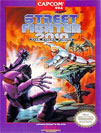
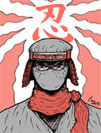
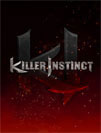
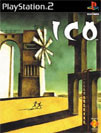
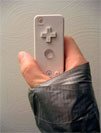
HOME |
CONTACT |
NOW HIRING |
WHAT IS DEFUNCT GAMES? |
NINTENDO SWITCH ONLINE |
RETRO-BIT PUBLISHING
Retro-Bit |
Switch Planet |
The Halcyon Show |
Same Name, Different Game |
Dragnix |
Press the Buttons
Game Zone Online | Hardcore Gamer | The Dreamcast Junkyard | Video Game Blogger
Dr Strife | Games For Lunch | Mondo Cool Cast | Boxed Pixels | Sega CD Universe | Gaming Trend
Game Zone Online | Hardcore Gamer | The Dreamcast Junkyard | Video Game Blogger
Dr Strife | Games For Lunch | Mondo Cool Cast | Boxed Pixels | Sega CD Universe | Gaming Trend
Copyright © 2001-2025 Defunct Games
All rights reserved. All trademarks are properties of their respective owners.
All rights reserved. All trademarks are properties of their respective owners.







